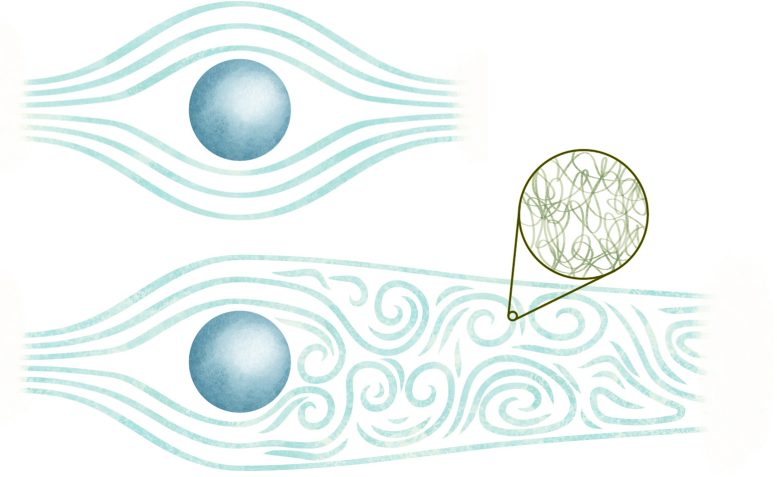Researchers have developed a theory suggesting the existence of quantum viscosity in superfluids, potentially bridging classical and quantum hydrodynamics. This novel approach, which involves analyzing the fall of a sphere in a superfluid, seeks to validate the Reynolds similitude in a quantum context, challenging long-held beliefs in fluid dynamics. Credit: SciTechDaily.com
A theoretical framework aimed at measuring Reynolds similitude in superfluids could potentially prove the presence of quantum viscosity.
Every liquid or gas, ranging from the air enveloping our planet to the blood coursing through our veins, possesses a measurable property known as viscosity. This property dictates how the fluid behaves when it comes into contact with any substance. If the viscosity is higher, the fluid flows calmly, a state known as laminar. If the viscosity decreases, the fluid undergoes the transition from laminar to turbulent flow.
The degree of laminar or turbulent flow is referred to as the Reynolds number, which is inversely proportional to the viscosity. The Reynolds law of dynamic similarity or Reynolds similitude, states that if two fluids flow around similar structures with different length scales, they are hydrodynamically identical provided they exhibit the same Reynolds number.
Quantum Superfluids and Reynolds Similitude
However, this Reynolds similitude is not applied to quantum superfluids, as they do not have viscosity — at least, that’s what researchers have believed. Now, a researcher from the Nambu Yoichiro Institute of Theoretical and Experimental Physics at Osaka Metropolitan University in Japan has theorized a way to examine the Reynolds similitude in superfluids, which could demonstrate the existence of quantum viscosity in superfluids.
(Upper) Drag is zero without quantum vortices at T=0. (Lower) Coarse-grained quantum vortices can reproduce the prediction of the Reynolds similitude by forming a turbulent wake with high Reynolds number defined with the quantum viscosity. The inset represents a microscopic view of quantum vortices in the turbulent wake. Credit: Hiromitsu Takeuchi, Osaka Metropolitan University
Dr. Hiromitsu Takeuchi, a lecturer in the Graduate School of Science at Osaka Metropolitan University, recently published his approach in Physical Review B.
Overturning Traditional Theories
“Superfluids have long been considered an obvious exception to the Reynolds similitude,” Dr. Takeuchi said, explaining that the Reynolds law of similitude states that if two flows have the same Reynolds number, then they are physically identical. “The concept of quantum viscosity overturns the common sense of superfluid theory, which has a long history of more than half a century. Establishing similitude in superfluids is an essential step to unify classical and quantum hydrodynamics.”
However, quantum superfluids can have turbulence, resulting in a quantum quandary: Turbulence in fluids requires dissipation, so how can superfluid turbulence experience dissipation without viscosity? They must have dissipation and may follow the Reynolds similitude, but the right approach to examine it had not yet been developed.
These characteristics could be examined, Dr. Takeuchi theorizes, by analyzing how a solid sphere falls into a superfluid. By combining the terminal speed of the sphere’s fall with the resistance the sphere encounters from the fluid as it falls, researchers can determine an analogue for the Reynolds similitude. This means effective viscosity, called the quantum viscosity, can be measured.
“This study focuses on a theoretical issue in understanding quantum turbulence in superfluids and shows that the Reynolds similitude in superfluids can be verified by measuring the terminal velocity of an object falling in a superfluid,” Dr. Takeuchi said. “If this verification can be made, then this suggests that quantum viscosity exists even in pure superfluids at absolute zero. I can’t wait to see it verified through experimentation.”
Reference: “Quantum viscosity and the Reynolds similitude of a pure superfluid” by Hiromitsu Takeuchi, 11 January 2024, Physical Review B.
DOI: 10.1103/PhysRevB.109.L020502
The study was funded by the Japan Science and Technology Agency, the Japan Society for the Promotion of Science, and the Osaka Metropolitan University (OMU) Strategic Research Promotion Project.
Note: This article have been indexed to our site. We do not claim legitimacy, ownership or copyright of any of the content above. To see the article at original source Click Here














